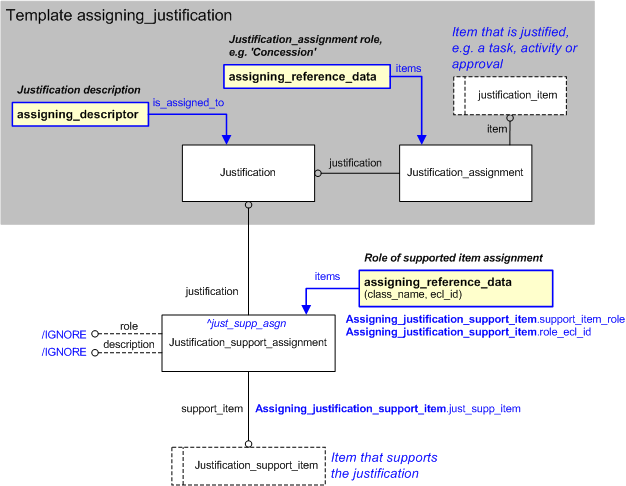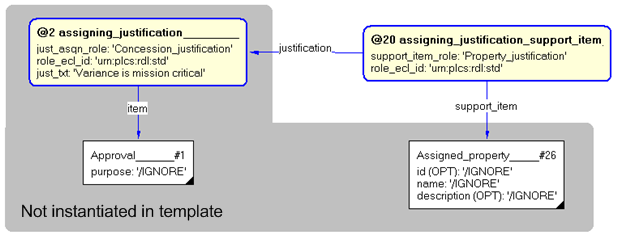Template:— assigning_justification_support_item (asg_just_support)
Capability:representing_justification |
Date: 2008/02/15 07:41:23
Revision: 1.12
|
This section specifies the template assigning_justification_support_item.
NOTE
The template has been defined in the context of the capability
representing_justification
which provides an overall description of the
relevant parts of the ISO 10303-239 information model and a description
of related templates.
NOTE
An explanation of a template and the associated instantiation path is
provided in the
Template overview
section.
This template describes how to represent supportive information to a justification, e.g.
a state definition, a supportive document, a property value, i.e. anything that supports the
justification and reason for divergence or discrepancy.
This template is intended to be used when supportive information exists, or when a simple
textual description of the justification is not enough. It is used together with template
assigning_justification.
Any number of support items may be assigned to a single justification.
The EXPRESS-G diagram in
Figure
1
shows the templates and EXPRESS entities that are required
to represent the template
"assigning_justification_support_item".
The text highlighted in blue shows the template parameters.
Figure 1 — An EXPRESS-G representation of the Information model for assigning_justification_support_item
The graphic for the template to be used in other EXPRESS-G diagrams
is shown in Figure
2
below.
Figure 2 — The graphical representation of the assigning_justification_support_item template
The following input parameters are defined for this template:
support_item_role (Default=Justification_support_assignment_role,Type='CLASS', Optional)
The following classes and their sub-classes can be used:
role_ecl_id (Default=urn:plcs:rdl:std,Type='URN', Optional)
The identifier of the
External_class_library
storing the definition of the class referenced by the parameter @support_item_role.
The following reference parameters are defined for this template:
%^target = $assigning_justification_support_item.just_supp_asgn%
The instantiation path shown below specifies the entities that are to be
instantiated by the template.
A description of templates and the syntax for the instantiation path is
provided in the
Templates Help/Information section.
The following entities are instantiated with attributes as specified:
The instance diagram in Figure
3
shows an example of the EXPRESS entities and templates that are instantiated by the template:
/assigning_justification_support_item(support_item_role='Property_justification', role_ecl_id='urn:plcs:rdl:std', justification='#3', just_supp_item='#25')/
(an illustration of the consolidated assigning_justification_support_item template is shown in
Figure
4 below.)
Figure 3 — Entities instantiated by assigning_justification_support_item template
The instance diagram in
Figure
4
shows the graphic symbol for the template that is to be
used in other instance diagrams. The example template is:
/assigning_justification_support_item(support_item_role='Property_justification', role_ecl_id='urn:plcs:rdl:std', justification='#3', just_supp_item='#25')/
Figure 4 — Instantiation of assigning_justification_support_item template
Characterizations
No common characterizations of the template
assigning_justification_support_item
have been identified. However, the ISO 10303-239 EXPRESS model
may enable other assignments to the entities instantiated by the template.




